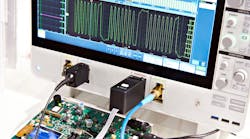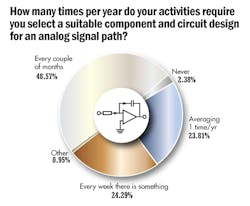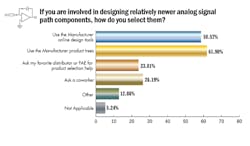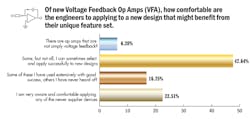The ABCs of Analog Signal-Path Design—and Coping with Today’s Challenges
Members can download this article in PDF format.
What you’ll learn:
- How analog signal engineering is performed, in broad strokes.
- What are the component-selection considerations for new designs?
- What are VFAs and how are they used?
Analog signal engineers specialize in designing, developing, and maintaining analog circuits and systems. The processing of analog signals is the manipulation of continuously varying signals, which are the opposite of digital signals that represent data as discrete values. Analog signals are still present in many electronic devices, including audio and video equipment, power supplies, and communication systems.
In this article, we will explore the role of analog signal engineers and the skills and knowledge required for success in this field based on a recent survey conducted by Endeavor Business Media.
So, What’s Analog Signal Engineering?
Analog signal engineering involves designing and analyzing electronic circuits that process continuous signals. Analog signals vary continuously in time, and their value can take on any value within a range.
Examples of analog signals include audio signals, which represent sound waves, and video signals, which represent images. Engineers in this arena develop circuits that process these signals, such as amplifiers, filters, and modulators.
The field of analog signal engineering is closely related to other fields, such as power electronics, RF (radio frequency) engineering, and control engineering. Analog signal engineers must understand basic electronics principles, including circuit analysis, circuit design, and semiconductor physics. They also must be proficient in using simulation and analysis tools to design and optimize electronic circuits.
Most engineers within the analog field will typically create designs every few months, and that requires operational knowledge of components currently on the market (Fig. 1). Engineers often take advantage of various component technologies through the design process for any number of applications, and a working knowledge of the latest components helps simplify that process.
Among the most commonly used analog technologies in signal-path design are operational amplifiers (op amps), comparators, and voltage regulators. Designs may require filters to remove unwanted frequency components from a signal or to isolate a particular frequency band.
Many analog engineers are familiar with the latest components and take advantage of manufacturers' updated products via product trees, filters, and even tools integrated within some design applications (Fig. 2). The design flows and options available to engineers have never been greater, and most are up-to-date within their respective fields.
To put that into perspective, the flow for the analog signal-path design process generally involves the following steps:
- System-level requirements: Define the overall specifications and requirements for the signal path, such as bandwidth, signal-to-noise ratio, and distortion.
- Circuit-level design: Design the individual components of the signal path, such as amplifiers, filters, and modulators. This may involve selecting specific circuit topologies and component values.
- Simulation: Use simulation software to verify that the signal path meets the system-level requirements as well as optimize the circuit-level design.
- Layout and fabrication: Create a layout for the signal path on a printed circuit board (PCB) and fabricate the PCB.
- Testing and characterization: Measure the performance of the signal path and compare it to the system-level requirements. Make any necessary adjustments to the design.
Some popular signal-path design options include:
- Analog signal processing: This includes traditional analog circuits such as op amps, filters, and mixers.
- Digital signal processing: Uses digital circuits and algorithms to process signals.
- Hybrid signal processing: A combination of both analog and digital signal processing.
- Software-defined radio: This uses a combination of analog and digital signal processing plus a microprocessor to implement a radio receiver or transmitter.
It's worth noting that some newer options include using machine learning and neural networks to process signals and utilizing integrated circuits (ICs) that integrate multiple signal-path components onto a single chip.
Component Selection
Selecting analog signal-path components also is crucial in designing and developing electronic circuits that process analog signals. Here are some essential factors to consider when selecting analog signal-path components:
- Signal frequency: The frequency range of the analog signal that the component will process is a key consideration. Some components, e.g., op amps, have a limited bandwidth and may not be suitable for processing high-frequency signals. Other components, e.g., inductors and capacitors, have a frequency-dependent response and must be selected based on the frequency range of the signal.
- Signal amplitude: The amplitude range of the analog signal is another important consideration when selecting components. Some components, e.g., amplifiers, must be selected based on their ability to process signals with a specific amplitude range. Other components, e.g., resistors and capacitors, may have a limited voltage or current rating and must be selected based on the signal amplitude.
- Noise: Noise is an unwanted signal that can degrade the performance of electronic circuits involved in processing analog signals. Components such as op amps and transistors can contribute to the noise in the signal path. When selecting components, it’s essential to consider their noise characteristics and select components with low noise levels.
- Linearity: Linearity is the ability of a component to accurately reproduce the input signal without distortion. Components such as amplifiers and filters must be selected based on their linearity characteristics to ensure accurate signal processing.
- Power-supply requirements: Some components, e.g., amplifiers and voltage regulators, require a specific power-supply voltage and current. It’s essential to consider the power-supply requirements of components when selecting them to ensure that the electronic circuit can operate correctly.
- Temperature range: Components can have a temperature-dependent response, and their performance may vary over a range of temperatures. When selecting components, it’s important to consider the temperature range of the electronic circuit and select components that can operate correctly over that range.
- Component availability: Finally, it’s essential to consider the availability of components when selecting them. Some components may be expensive or difficult to obtain, which can impact the overall feasibility of the electronic circuit.
Selecting analog signal-path components requires careful consideration of the signal frequency, amplitude, noise, linearity, power-supply requirements, temperature range, and component availability. By carefully selecting components that meet these criteria, analog signal engineers can design and develop electronic circuits that accurately process analog signals (Fig. 3).
The Venerable VFA
One of the more widely used components when designing analog devices is the original voltage-feedback op amp (VFA). VFAs are a type of electronic amplifier used in a wide range of analog-signal-processing applications. These op amps have a voltage input and output and are typically used for applications that require high-gain amplification and precision signal processing. In a VFA, the input voltage is applied to the inverting or non-inverting input of the amplifier.
The op amp amplifies the input voltage by a specific factor known as the gain, which is determined by the feedback network. The op amp's output voltage is then fed back to the input through a feedback resistor, which stabilizes the gain and improves the amplifier's stability.
One of the key advantages of VFAs is their versatility. They can be used in various applications, including analog signal processing, signal conditioning, active filters, oscillators, and voltage regulators. They’re also relatively simple to use, with most op amps requiring only a few external components to configure them for a specific application.
However, some limitations to voltage feedback op-amps also must be factored in. For example, they may have limited bandwidth or gain accuracy when used in certain applications. In addition, they may be prone to oscillation or instability if the feedback network isn’t properly designed.
Signal conditioning is a process engineers use to manipulate an input signal to make it suitable for measurement or control system processing. This typically involves amplifying, filtering, or modifying the signal to improve its quality or make it compatible with the system's requirements. Signal conditioning is often used with current-sense circuits and instrument amplifiers to amplify small signals and monitor power.
In a typical current-sense circuit using an instrumentation amplifier, the shunt resistor is placed in series with the current path, and the instrumentation amplifier amplifies the voltage across the resistor. The output of the amplifier is then processed by a filter or other signal-conditioning circuit to remove any unwanted noise or distortion and provide a clean, accurate measurement of the current.
Depending on the application, signal conditioning also may require using analog-to-digital converters (ADCs) and digital-to-analog converters (DACs) to alter the signal. Most engineers will utilize legacy voltage feedback using current-feedback op amps and fully differential amplifiers. Signal processing leading up to an ADC typically involves several steps to prepare the analog signal for conversion, including filtering, amplifying, and holding a signal at a constant level before deployment.
Signal processing leading away from a DAC is similar to ADCs, although the signal needs to be shaped to match the requirements of the analog device. The signal also may need conditioning before entering the output stage to provide a specific frequency or amplitude response. This can be done using current fully differential amplifiers, and in some cases, higher input voltages.
Conclusion
Analog signal design engineering is a challenging and rewarding field that requires a strong educational background, a broad set of skills, and a dedication to staying up-to-date with the latest advances in circuit design and signal processing. Although engineers within the analog signal-path design field may find themselves in the minority, those numbers could change over the next decade as legacy systems continue to be a mainstay in the development process.
The future of analog signal-path design will likely involve continued advances in technology, such as using more advanced materials and fabrication techniques and incorporating digital signal processing (DSP) into analog signal-path design.
Furthermore, there may be a greater focus on designing for specific applications, such as medical imaging, communications, and automotive systems. The use of machine-learning algorithms and artificial intelligence could also play a role in the future of analog signal-path design, helping to optimize and improve the performance of analog signal-path circuits.




